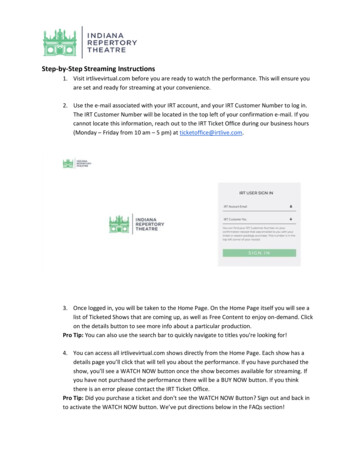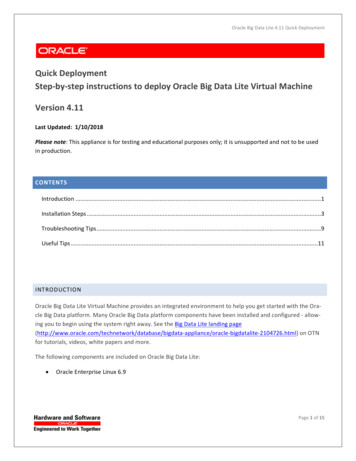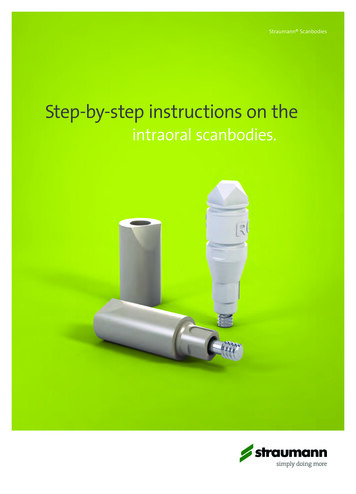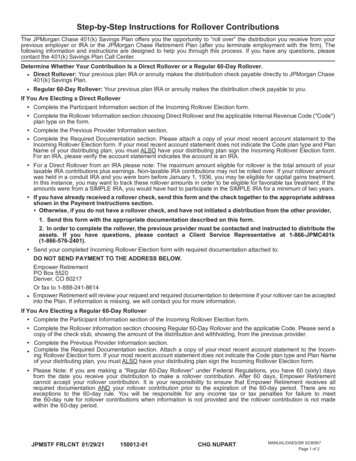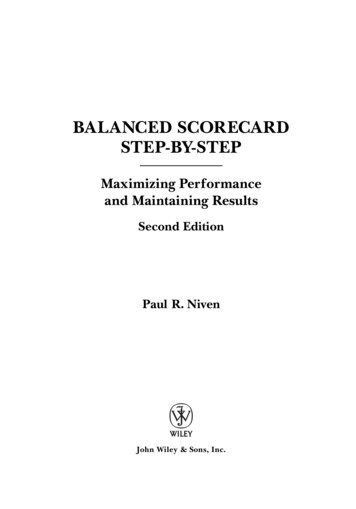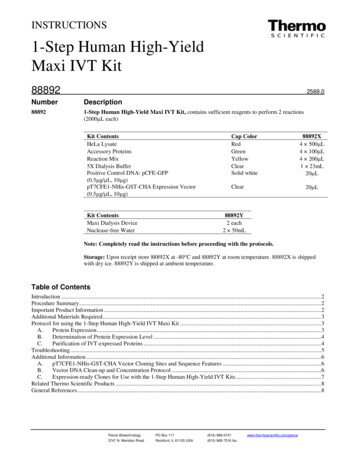
Transcription
INSTRUCTIONS1-Step Human High-YieldMaxi IVT Kit888922569.0NumberDescription888921-Step Human High-Yield Maxi IVT Kit, contains sufficient reagents to perform 2 reactions(2000µL each)Kit ContentsHeLa LysateAccessory ProteinsReaction Mix5X Dialysis BufferPositive Control DNA: pCFE-GFP(0.5µg/µL, 10µg)pT7CFE1-NHis-GST-CHA Expression Vector(0.5µg/µL, 10µg)Kit ContentsMaxi Dialysis DeviceNuclease-free WaterCap ColorRedGreenYellowClearSolid whiteClear88892X4 500µL4 100µL4 200µL1 23mL20µL20µL88892Y2 each2 50mLNote: Completely read the instructions before proceeding with the protocols.Storage: Upon receipt store 88892X at -80 C and 88892Y at room temperature. 88892X is shippedwith dry ice. 88892Y is shipped at ambient temperature.Table of ContentsIntroduction . 2Procedure Summary. 2Important Product Information . 2Additional Materials Required . 3Protocol for using the 1-Step Human High-Yield IVT Maxi Kit . 3A.Protein Expression . 3B.Determination of Protein Expression Level . 4C.Purification of IVT-expressed Proteins . 4Troubleshooting . 5Additional Information . 6A.pT7CFE1-NHis-GST-CHA Vector Cloning Sites and Sequence Features . 6B.Vector DNA Clean-up and Concentration Protocol . 6C.Expression-ready Clones for Use with the 1-Step Human High-Yield IVT Kits . 7Related Thermo Scientific Products . 8General References . 8Pierce BiotechnologyPO Box 117(815) 968-07473747 N. Meridian RoadRockford, lL 61105 USA(815) 968-7316 faxwww.thermoscientific.com/pierce
IntroductionThe Thermo Scientific 1-Step Human High-Yield Maxi IVT Kit is a mammalian in vitro translation (IVT) system based onHeLa cell lysates, which contain all of the cellular components required for protein synthesis, including ribosomes, initiationfactors, elongation factors and tRNA. When supplemented with the included proprietary Accessory Proteins, Reaction Mixand a DNA template cloned into the Thermo Scientific pT7CFE1-NHis-GST-CHA Vector, this system can synthesizeprotein for up to 16 hours.The benefits of in vitro protein expression over traditional in vivo systems include the ability to express toxic proteins, fasterprotein synthesis and protein labeling with modified amino acids. The optimized kit contains a T7 promoter and an EMCVinternal ribosome entry site (IRES) to facilitate high levels of in vitro protein expression in a cap-independent fashion. Usinga vector containing the EMCV IRES element is critical for obtaining high expression levels in this human in vitro proteinexpression system.Procedure SummaryImportant Product Information Use the included Thermo Scientific pT7CFE1-NHis-GST-CHA Vector (Product No. 88871) for cloning andexpressing the target gene. See the Additional Information Section for additional vector choices, cloning sites andexpression-ready clones. Thaw HeLa Lysate on ice, aliquot and quickly store at -80 C. All components of the kit are stable for up to five freezethaw cycles as long as the contents are stored at -80 C immediately after use. For faster thawing, gently flick the lysatetubes. Undiluted lysate and reactions containing lysate will appear cloudy before and after incubation. Accessory Proteins andReaction Mix may also appear clear to cloudy upon thawing; mix thoroughly but gently before and after adding eachcomponent to the IVT reaction. Undiluted 5X Dialysis Buffer may appear cloudy; mix well before and after dispensing. Avoid RNase contamination by wearing gloves; working in a clean, dust-free environment; and using RNase-free tipsand microcentrifuge tubes.Pierce BiotechnologyPO Box 117(815) 968-07473747 N. Meridian RoadRockford, lL 61105 USA(815) 968-7316 fax2www.thermoscientific.com/pierce
Additional Materials Required DNA preparation kit (e.g., Thermo Scientific GeneJET Plasmid Maxi Prep Kit, Product No. K0492) Western immunoblot accessories for detecting expressed protein FITC filter-containing device to observe the expression of GFP in positive control reactions 1.5mL and 15mL RNase-free microcentrifuge tubes for assembling reactions RNase-free pipette tips Shaker incubator capable of maintaining temperature at 30 C.Protocol for using the 1-Step Human High-Yield IVT Maxi KitA. Protein Expression1.With the exception of 5X Dialysis Buffer, thaw all other reagents in the kit contents of 88892X and maintain on ice.Thaw 5X Dialysis Buffer at 25-30 C for a maximum of 30 minutes, and after making a 1X mixture, maintain the dilutedbuffer at 30 C.Note: Store any unused 88892X kit components at -80 C.Note: The 5X Dialysis Buffer may appear cloudy. Mix or vortex gently. Do not centrifuge before use. Once diluted, the1X Dialysis Buffer will become clear within minutes.2.Combine 5X Dialysis Buffer and Nuclease-free Water (volumes per Table 1) in the provided conical tube.Table 1. Reconstitution of the Dialysis Buffer.Component5X Dialysis BufferNuclease-free WaterTotalmL8.032.040.03.Place a dialysis device inside the 50mL tube containing 1X Dialysis Buffer as shown in the Procedure Summary Section.4.Optional: Set up a small reaction to test the integrity of the HeLa Lysate, Accessory Proteins and Reaction Mix. Add12.5μL of HeLa Lysate, 2.5μL of Accessory Proteins, 5μL of Reaction Mix, 3μL of Nuclease-free Water and 2μL ofpCFE-GFP DNA plasmid to a nuclease-free 1.5mL microcentrifuge tube. Incubate at 30 C for 4-5 hours. See Section B,Step 1: Quick visual detection for detecting the expressed GFP protein.5.Prepare IVT reactions using Table 2. Add the reagents in the order listed into a 15mL RNase/DNase-free tube. Gentlymix the reaction after each reagent addition. Incubate HeLa Lysate with Accessory Proteins for 10 minutes at roomtemperature prior to adding the rest of the components.Table 2. Components of the IVT reaction.µLComponentHeLa LysateAccessory ProteinsReaction MixCloned DNA(0.5µg/µL)Nuclease Free water1000200400160240Total2000Pierce BiotechnologyPO Box 117(815) 968-07473747 N. Meridian RoadRockford, lL 61105 USA(815) 968-7316 fax3www.thermoscientific.com/pierce
6.Briefly centrifuge the reaction mix at 10,000 g for 2 minutes. A small pellet will be visible after centrifugation.7.Transfer the supernatant into the empty dialysis device and screw the cap on the device as described in the ProcedureSummary Section.8.Place the entire dialysis device into the 50mL tube containing Dialysis Buffer and close the screw cap.9.Incubate the reaction for 6-16 hours at 30 C in a shaker incubator. Shake the entire unit in a shaker incubator using thefollowing guidelines to determine the speed of shaking.Shaker orbital radiusRecommended RPM3mm (Eppendorf ThermoMixer )3503/4 inch (New Brunswick C24)2501 inch (Thermo Scientific MaxQ 8000)150Note: Although protein expression is complete within six hours for most proteins tested, incubating up to 16 hours mayincrease expression of some proteins. Optimal time to express each protein must be determined empirically. A smallwhite precipitate may be visible, which can be easily removed by centrifugation in the next step.10. At the end of incubation, collect the contents from the dialysis device equally into two separate 1.5mL microcentrifiugetubes and centrifuge at 10,000 g for 2 minutes prior to storage.Note: Resulting reactions may be stored on ice for same-day use. For long-term storage, transfer the reaction contentsfrom the dialysis device and store separately at -20 C or colder.11. Proteins expressed using this kit may be purified using the purification guidelines provided in the Product Blog article“Choosing a vector and purification method for in vitro protein expression” on our website at: thermoscientific.com/pierce.B. Determination of Protein Expression LevelNote: The GFP control protein is from the copepod Pontellina plumata. This GFP is not reactive to antibodies generatedagainst Aequorea victoria GFP (i.e., EGFP or other EGFP mutants). Use polyclonal antibodies to TurboGFP (Product No.PA5-22688).1.Visualize or quantitate the GFP control protein using one of the following methods:Quick visual detection: Place the GFP reaction tubes directly under a microscope or imaging equipment containing aFITC filter (ex/em: 482/502nm); alternatively, spot a small volume (1-2µL) on a piece of plastic wrap or laboratory filmand visualize with fluorescent imaging equipment.Fluorescent plate reader: Place sample directly into a white or black 96- or 384-well plate. Evaluate signal using afluorescent plate reader at ex/em: 482/502nm. To quantitate GFP, compare the fluorescence to a recombinant GFPstandard curve.2.Visualize or quantitate non-fluorescent protein expression using one of the following methods:Fast Western immunoblot analysis: This is a quick protocol consisting of transfer and detection of proteins separatedon SDS-PAGE using ultra-sensitive Thermo Scientific SuperSignal Substrate. A detailed protocol and reagentsrequired for Western blot detection can be found at thermoscientific.com/pierce; search using “fast western blot.”SDS-PAGE analysis: Separate proteins by SDS-PAGE and stain using Thermo Scientific GelCode Blue StainReagent (Product No. 24590), Thermo Scientific Imperial Protein Stain (Product No. 24615) or ThermoScientific PageBlue Protein Staining Solution (Product No. 24620) (Figure 2).C. Purification of IVT-expressed ProteinsProteins expressed using this kit may be purified using the purification guidelines provided in the Product Blog article“Choosing a vector and purification method for in vitro protein expression” on our website at: thermoscientific.com/pierce.Pierce BiotechnologyPO Box 117(815) 968-07473747 N. Meridian RoadRockford, lL 61105 USA(815) 968-7316 fax4www.thermoscientific.com/pierce
TroubleshootingProblemPossible CauseSolutionGFP not detected byfluorescence in positivecontrol reactionIncorrect filter set was usedThe excitation/emission wavelengths of GFP are482/502nmLysates have become inactiveStore unused lysate in nuclease-free tubes at -80 C; donot exceed five cycles of freezing and thawingNo expression of targetproteinIncorrect vector was usedUse cloning vector pT7CFE1-NHis-GST-CHA providedin the kit to clone and express the gene of interestNote: The 1-Step Human IVT Kits are optimized usingthe pCFE1 vector and its derivatives; for a completelisting, please visit thermoscientific.com/pierceHeLa Lysate, Accessory Proteinsand Reaction Mix were stored at asuboptimal temperatureStore unused HeLa Lysate, Accessory Proteins andReaction Mix in nuclease-free tubes at -80 C; do notexceed five cycles of freezing and thawingPoor-quality DNAEthanol precipitate the DNA to remove trace amounts ofinhibitors or salts see the Additional InformationSection for the recommended protocolDegradation of mRNA in thetranslation reactionMaintain an RNase-free environment by wearinggloves; working in a clean, dust-free environment; andusing RNase-free tips and microcentrifuge tubesProtein was sensitive to proteasesAdd Thermo Scientific Halt Protease InhibitorSingle-Use Cocktail, EDTA-free (100X) (Product No.78425) at 0.5X to the reaction mix in Step A, 5, Table 2Low yield of targetproteinsIncorrect incubation temperaturePerform reactions at 30 CIncorrect order of reagent additionIncubate HeLa Lysate with Accessory Proteins for5-10 minutes before adding remaining components toimprove target protein expressionSmaller band size thanpredictedStop codons were in genes ofinterestEnsure the cloned genes do not have a stop codon in theopen reading frameProtein appears to bedegradedProteins were susceptible toproteasesAdd Halt Protease Inhibitor Single-Use Cocktail,EDTA-free (100X) (Product No. 78425) at 0.5X to thereaction mix in Step A, 5, Table 2Larger band size thanpredictedPost-translation modificationsHeLa Lysate is capable of protein post-translationalmodifications, including partial glycosylation andphosphorylation. Validate the presence of glycosylationby digesting a small portion of the sample with Endo Hor PNGase (a loss of the higher molecular weight bandsindicates proteins were glycosylated)Low protein yield after
The Thermo Scientific 1-Step Human High-Yield Maxi IVT Kit is a mammalian in vitro translation (IVT) system based on HeLa cell lysates, which contain all of the cellular components required for protein synthesis, including ribosomes, initiation factors, elongation factors and tRNA. When supplemented with the included proprietary Accessory Proteins, Reaction Mix

